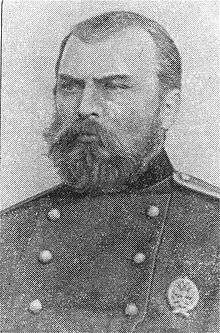Fyodor Pirotsky

Fyodor Apollonovich Pirotsky (Russian: Фёдор Аполлонович Пироцкий; February 17 [O.S. March 1] 1845- February 28 [O.S. March 12] 1898) was a Russian[1][2][3][4][5] engineer of Ukrainian origin and inventor of the world's first railway electrification system and electric tram.[6][7][8][9][10] While the commercialization of his inventions in Russia was relatively slow, Pirotsky is known to have met with Carl Heinrich von Siemens and influenced Siemens' eventual introduction of the first regular electric tram line (for the Berlin Straßenbahn).
Biography
Fyodor was born to the family of a military physician in Lokhvytsia Uezd of Poltava Gubernia (currently, Ukraine) of the Russian Empire. His family was of Ukrainian Cossacks ancestry.
Fyodor received his education at Saint Petersburg, where he graduated from the Konstantin Cadet Corps (Konstantinovskiy Kadetskiy Korpus) and Mikhail Artillery School in 1866, and served in Kiev with the Fortress Artillery. There he became a friend of the famous Russian electrical engineer Pavel Yablochkov and an enthusiast for applications of electrical energy.

Work
In 1871, Pirotsky moved back to Saint Petersburg, where among other things he proposed a new type of blast furnace. In 1874, he started experiments on Volkov Field in Saint Petersburg and in 1875 put electrically powered railway cars on the Sestroretsks railway Miller's line (not far from the station Miller's pier).[11] The electricity was transferred over a distance of approximately one kilometer. In his design rails were connected to a Gramme generator. Both rails were isolated from the ground, one rail served as a direct conductor and one as a reverse conductor.
In 1880, he modified a city two-decker horse tramway to be powered by electricity instead of horses, and on 3 September [O.S. August 22] 1880 the unusual form of public transport started to serve residents of Saint Petersburg amid the vocal protests of the owners of the horse-cars. The experiments continued until the end of September 1880. Some historians claim that this was the first electric tram in the world. Pirotsky did not have the money to continue his experiments, but his works stirred interest in electric trams around the world. Among people who met Pirotsky was Carl Heinrich von Siemens who was very interested and asked many questions. In 1881 the brothers Siemens started producing their own design of electric trams commercially. The first permanent electric tram line using Siemens tram cars was opened in Berlin in 1881 and the first permanent tram line in the Russian Empire was opened in Kiev in 1892.
Pirotsky continued to serve as an artillery officer of the Imperial Russian Army. Among other things he installed the first underground electric cable in Saint Petersburg to transfer electricity from a cannon foundry to the Artillery School (1881). He also was the author of a project for centralizing the city's electricity production using underground cables, he proposed new constructions of blast furnaces and bakery ovens. In 1888 he retired with the rank of colonel, lived on his military pension in the town of Aleshki (now Oleshky, Kherson Oblast, Ukraine)[12] and died in 1898. Since no money was found on him when he died, the burial was paid for by a credit secured by the colonel's furniture.
See also
Sources
- Belkind L. D., Konfederatov I. Ya., Shneyberg Ya. A. (Белькинд Л. Д., Конфедератов И. Я., Шнейберг Я. А.), История техники, М.— Л. (History of Engineering, Moscow-Leningrad), 1956 (Russian).
References
- ↑ C. N. Pyrgidis. Railway Transportation Systems: Design, Construction and Operation. CRC Press, 2016. P. 156
- ↑ Ye. N. Petrova. St. Petersburg in Focus: Photographers of the Turn of the Century ; in Celebration of the Tercentenary of St. Petersburg. Palace Ed., 2003. P. 12
- ↑ М. И. Кузнецов. Основы электротехники. М.: Высшая школа. 1964. C. 6 (Russian)
- ↑ Museum of the History of Electricity in Northwest Russia (Russian)
- ↑ Ю. П. Рыжов. Дальние электропередачи свервысокого напряжения. М.: МЭИ. 2007. С. 11 (Russian)
- ↑ C. N. Pyrgidis. Railway Transportation Systems: Design, Construction and Operation. CRC Press, 2016. P. 156
- ↑ Ye. N. Petrova. St. Petersburg in Focus: Photographers of the Turn of the Century ; in Celebration of the Tercentenary of St. Petersburg. Palace Ed., 2003. P. 12
- ↑ Korney Kolomnov, Where the Tram Came From (Откуда Есть Пошёл Трамвай) at the Wayback Machine (archived June 30, 2003), Zerkalo Nedeli, 379 (Russian). (web.archive.org copy from 2003-06-30.)
- ↑ "Ретро-трамвай — петербургская классика :: Биография Фёдора Пироцкого" (in Russian). 2006. Retrieved 2007-07-17.
- ↑ Форум донецкого метрополитена :: Просмотр темы - 3 сентября трамваю исполняется 125 лет (in Russian). 2005. Retrieved 2007-07-17.
- ↑ Chepurin, Sergey; Arkady Nikolayenko (May 2007). "Sestroretsk and Primorskaya railways (Сестрорецкая и Приморская железные дороги)" (in Russian). Retrieved 2009-02-21.
- ↑ АМУ (in Russian). Retrieved 2007-07-17.